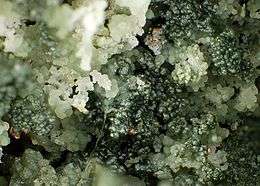Saponite
Saponite is a trioctahedral mineral of the smectite group. Its chemical formula is Ca0.25(Mg,Fe)3((Si,Al)4O10)(OH)2·n(H2O).[2] It is soluble in sulfuric acid. It was first described in 1840 by Svanberg. Varieties of saponite are griffithite, bowlingite and sobotkite.
| Saponite | |
|---|---|
 Saponite (light green) mixed with chamosite (dark green) and copper | |
| General | |
| Category | Phyllosilicates Smectite group |
| Formula (repeating unit) | Ca0.25(Mg,Fe)3((Si,Al)4O10)(OH)2·n(H2O) |
| Strunz classification | 9.EC.45 |
| Crystal system | Monoclinic |
| Crystal class | Prismatic (2/m) (same H-M symbol) |
| Space group | C2/m |
| Unit cell | a = 5.3 Å, b = 9.14 Å c = 16.9 Å; β = 97°; Z = 2 |
| Identification | |
| Color | White, yellow, red, green, blue |
| Crystal habit | Granular - Massive |
| Cleavage | {001} perfect |
| Tenacity | Brittle dry, plastic when hydrated |
| Mohs scale hardness | 1.5 |
| Luster | Greasy, dull |
| Streak | White |
| Diaphaneity | Translucent |
| Specific gravity | 2.24 - 2.30 |
| Optical properties | Biaxial (-) |
| Refractive index | nα = 1.479 - 1.490 nβ = 1.510 - 1.525 nγ = 1.511 - 1.527 |
| Birefringence | δ = 0.032 - 0.037 |
| Pleochroism | X = colorless, light yellow to green-brown; Y = Z = colorless, greenish brown to dark brown |
| 2V angle | Calculated: 20° to 26° |
| References | [1][2][3] |
It is soft, massive, and plastic, and exists in veins and cavities in serpentinite and basalt. The name is derived from the Greek sapo, soap. Other names include bowlingite; mountain soap; piotine; soapstone.
Occurrence
Saponite was first described in 1840 for an occurrence in Lizard Point, Landewednack, Cornwall, England.[2] It occurs in hydrothermal veins, in basalt vesicles, skarns, amphibolite and serpentinite. Associated minerals include celadonite, chlorite, native copper, epidote, orthoclase, dolomite, calcite and quartz.[3]
Saponite is found in Ząbkowice Śląskie in Silesia, Svärdsjö in Dalarna, Sweden and in Cornwall, UK. The soap stone of Cornwall is used in the porcelain factory. Saponite is also found in the "dark rims" of chondrules in carbonaceous chondrites and seen as a sign of aqueous alteration.[4]
See also
- Classification of minerals
- List of minerals
References
- Webmineral data
- Mindat.org
- Handbook of Mineralogy
- Zolensky, Michael; Barrett, Ruth; Browning, Lauren (July 1993). "Mineralogy and composition of matrix and chondrule rims in carbonaceous chondrites". Geochimica et Cosmochimica Acta. 57 (13): 3123–3148. Bibcode:1993GeCoA..57.3123Z. doi:10.1016/0016-7037(93)90298-B.
This article contains material from the U.S. Bureau of Mines Dictionary of Mining, Mineral, and Related Terms.
| Wikimedia Commons has media related to Saponite. |